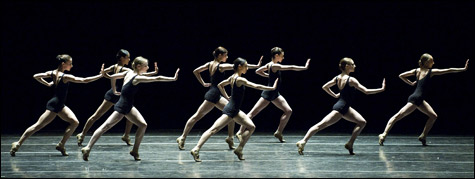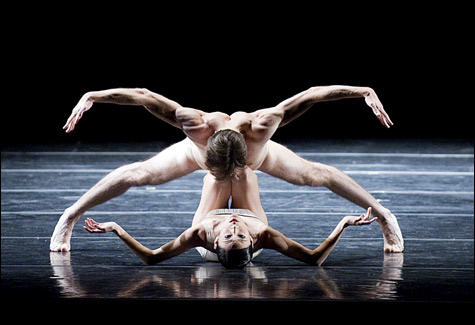
FALLING ANGELS: For women only, it's the Eleusinian Mysteries of dance.
|
Czech choreographer/Nederlands Dans Theater director Jirí Kylián made his Black & White Ballets out of five pieces — No More Play, Petite Mort, Sarabande, Falling Angels, and Sechs Tänze — he’d created between 1986 and 1991, and it’s an unnerving investigation of sexual politics and sexual identity, now dark, now goofy. Kylián’s brand of Eurotheater hasn’t always been popular with critics on this side of the Pond, but this past weekend, when Boston Ballet became the first company outside the Netherlands to perform the complete Black & White, Wang Theatre audiences ate it up. So much for the notion that Boston is interested only in classical story ballets.
Kylián’s unifying device is a set of formal, mostly black, late-18th-century dresses, just the bodice and the full skirt, hung on a framework with rollers. The dancers, men as well as women, pop up from behind them and pose, push them on and off stage. During Sarabande, the dresses rise and hover above the dancers. Kylián also makes use of foils in Petite Mort, and the operatic shenanigans of Sechs Tänze, which is set to Mozart’s K.571 German Dances, are presented in period undergarments and powdered wigs and chalky make-up. The choreography, whose many repeating tropes also unify the set, is so spiky and so charged, the props are almost a distraction.
Set to Anton Webern’s savage, shadowy Five Movements for Strings, No More Play began Thursday with Sabi Varga standing behind Yury Yanowsky and holding his hands in front of Yanowsky’s eyes and stomach, as if he were the Elegy Angel from Balanchine’s Serenade; meanwhile, stage left, Lorna Feijóo, Nelson Madrigal, and Kathleen Breen Combes moved in lockstep like marionettes. This one’s in edgy twos and threes. During the nocturnal second movement, Breen Combes stands on Varga’s thighs and pulls him up, and later she stands on the back of his knee and does an arabesque. In the last movement, Feijóo and Madrigal sit at the front of the stage with their legs dangling over the edge and cast huge shadows on the back wall. At the end, all five sit facing away from us and then lie back, heads hanging over the edge of the stage. It’s a community — but unlike those of Twyla Tharp and Mark Morris, it’s not one we’re invited to join.

PETITE MORT: The title may mean orgasm, but Rie Ichikawa keeps Roman Rykine at a distance.
|
Petite Mort (French slang for “orgasm”) opens with six men in flash-toned corset briefs backing toward us, each balancing a foil on his right index finger. They swish the foils, roll them around on the floor with a toe, execute a kind of rifle drill. Eventually six women come forward behind the dresses and make love to them. We get, one by one, six duets; on more than one occasion, a man’s descent into his partner is blocked by her knees and he floats on them. The gorgeous slow movements from Mozart’s Piano Concertos Nos. 23 and 21 counterpoint the jousting. At the end, five of the six dresses are rolled from the wings toward center stage.